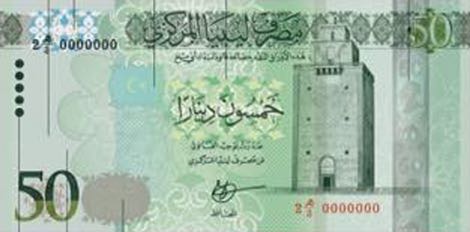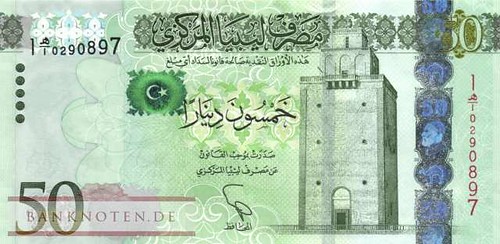
PREV ARTICLE
NEXT ARTICLE
FULL ISSUE
PREV FULL ISSUE
LIBYA'S RIVAL BANKNOTESLoren Gatch writes: " I saw that item about Yemen's rival banknotes. Coincidentally, my latest column in Paper Money was about this as well (also about what is happening in Libya, which I think is even weirder)." 
Russian-printed Libya 50-dinar banknote https://banknotenews.com/?p=5887 
De La Rue-printed Libya 50-dinar banknote https://www.banknoten.de/product_info.php?info=p55685_libya---50--dinars---080-unc-.html With permission, we're republishing the section of Loren's article on Libya's rival banknotes. Thanks. -Editor Unlike Yemen, Libya's divide runs east to west, rather than north to south. Ruled for over forty years with bad-boy flair by Muammar Gaddafi, Libya descended into turmoil after 2011, when the Arab Spring and western interventions led to Gaddafi's overthrow and death. Despite UN attempts to keep the country together, after 2014 political authority in Libya split between a so-called House of Representatives, centered in Tobruk, and a UN-backed Government of National Accord located in Tripoli. This division of authority is awkward in a fundamental way. Libya's oil fields lie in the east, while the Bank of Libya in Tripoli is the sole authorized recipient of precious hard currency from the country's oil exports. Occupying Tripoli would give the eastern government control over those export receipts as well as access to some $70 billion in foreign exchange reserves. The eastern forces, known as the Libyan National Army, commanded by Khalifa Haftar, have scored military successes in the west and by 2019 threatened to advance towards Tripoli itself. Haftar's big problem has been finding the funds to pay his troops and pay off his motley militia allies. In addition to support from the Egyptians and the Emiratis (among others), Haftar has financed his operation by creating a parallel banking system, and even a parallel dinar currency, all managed by a renegade branch of the Bank of Libya in the eastern city of Beida. Libya has been a longstanding customer of De La Rue, the printer of its current banknotes. Yet in 2016, the eastern Bank of Libya began taking delivery of its own supplies of Libyan dinars, printed by Russia's Goznak. By the end of 2018, the Russians had provided over 10 billion dinars' worth of this alternative supply, even as De La Rue continued its own deliveries to the western Bank of Libya. Enforcing an international embargo on the eastern Libyan government, in November 2019 the government of Malta seized a huge transshipment of this unofficial Libyan currency, apparently destined for Haftar, much to Russia's annoyance. While the two varieties of dinar look similar, they are readily distinguishable by their different watermarks, serial numbers, and other security features. The eastern government is in effect financing its rebellion via a massive counterfeiting operation. Yet it is not at all clear that the government in Tripoli could repudiate this unauthorized currency, even if it wanted to. Doing so at this point might simply create a liquidity crisis for the entire Libyan economy. As Lincoln once predicted about his own divided nation, "it will become all one thing or all the other." Likewise, in both Yemen and Libya there doesn't seem to be any plausible equilibrium between the opposing sides. Perhaps in some distant future, Libyan dinars and Yemeni rials will persist only as numismatic curios, like the Biafran pound or the Katanganese franc, testaments to failed secessionist aspirations and to the sufferings of the people who used them. Loren adds: "The easiest difference to see is the placement of the serial number, which is horizontal on the Russian-printed notes, and uses the same font size throughout the run of the number. The Libyan Central Bank's dinar notes have a vertical serial number, with ascending font size." Loren pointed me to images of the notes online. Thanks! -Editor To read the earlier E-Sylum article, see:
Wayne Homren, Editor The Numismatic Bibliomania Society is a non-profit organization promoting numismatic literature. See our web site at coinbooks.org. To submit items for publication in The E-Sylum, write to the Editor at this address: whomren@gmail.com To subscribe go to: https://my.binhost.com/lists/listinfo/esylum All Rights Reserved. NBS Home Page Contact the NBS webmaster 
|